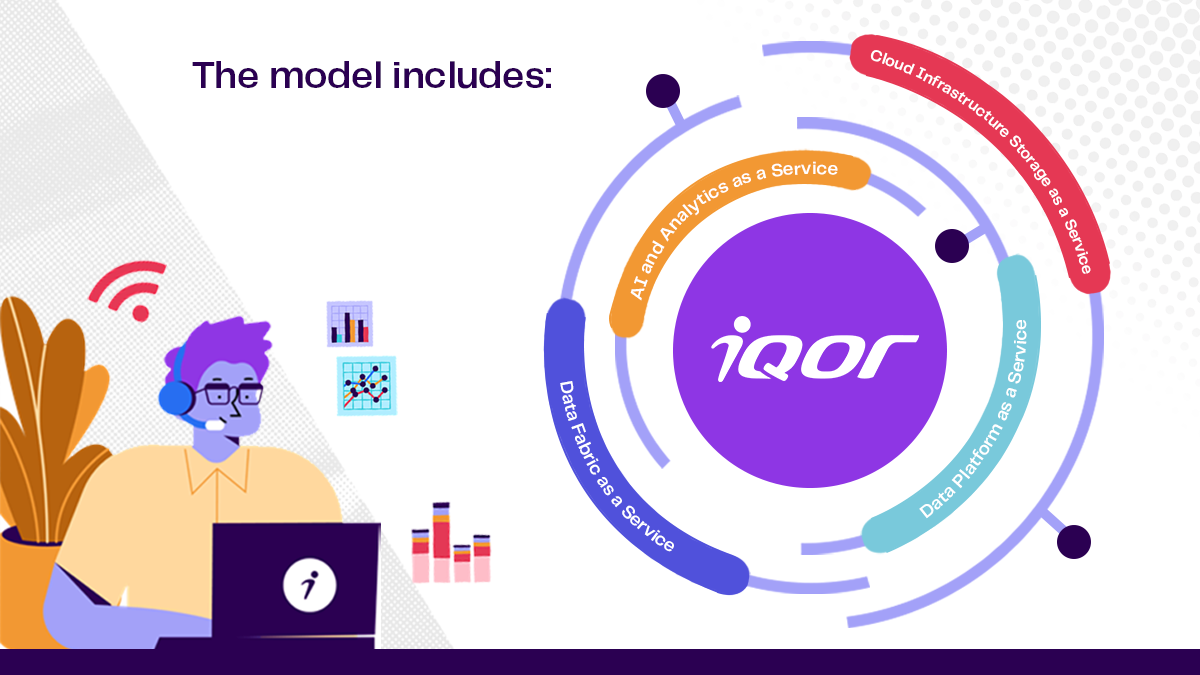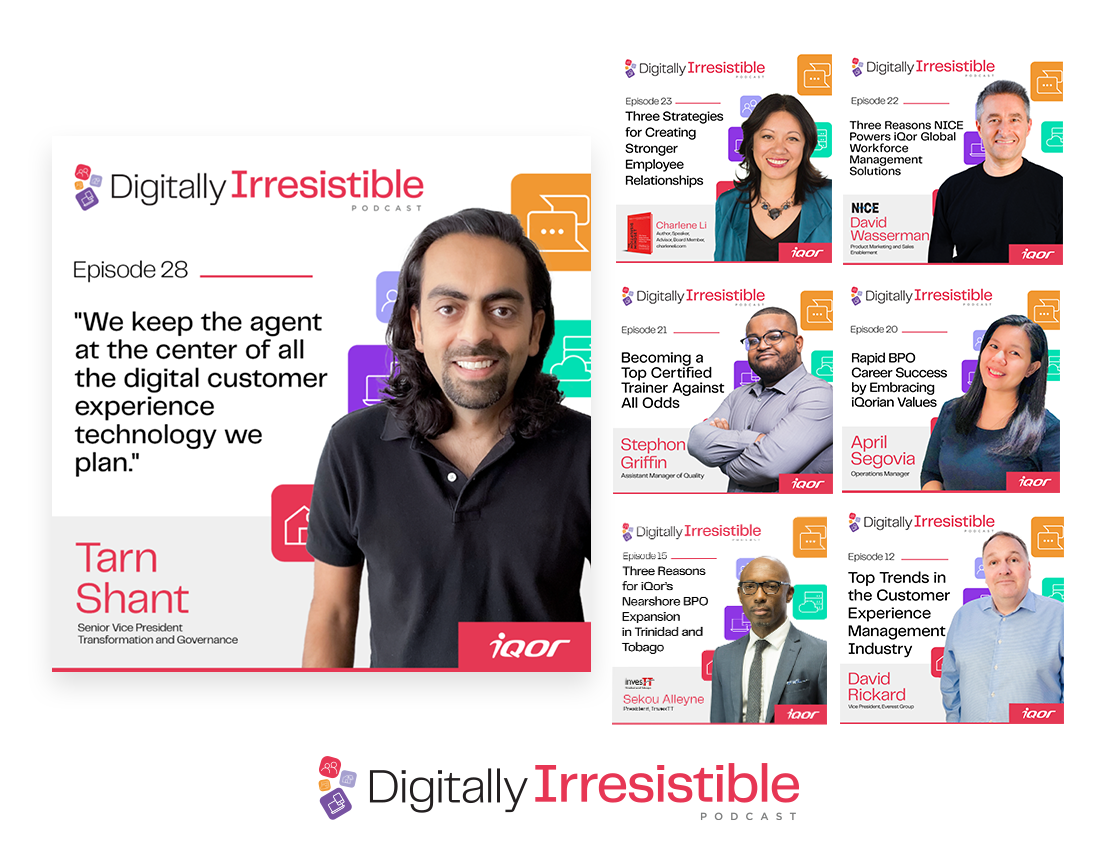
Optimize Your Customer Experience Through Digital Transformation
Consumers are on their own digital transformation journey. For them, it’s all about choice. When they can interact with your brand through their preferred digital channels and speak (or message) with a customer support representative anytime, anywhere, consumers are able to address their concerns and get satisfactory answers to their questions.
Digital transformation also has its place on the contact center side. More empowered customers result in call deflections and cost savings while enabling agents to focus on high-value customer interactions and provide quality service to complex issues. Cloud-enabled tools such as robotic process automation (RPA), intelligent IVR, chatbots, and data analytics all play a role in providing frontline support staff a deeper understanding of the customer journey, empowering them to deliver an optimal customer experience.
In this article, we dive into the impact of digital transformation on the customer experience journey. From intelligent self-service to omnichannel support to empowering agents with digital tools, the digital transformation journey allows your brand to maximize customer lifetime value.
 INTRODUCTION
INTRODUCTION
Keeping it Human in the Digital Customer Experience
in the Digital Customer Experience
THE STRATEGY
Every brand is unique yet the digital customer experience strategy should answer these questions along the customer journey.
How can I help my customers solve their issues on their own?
If they still need answers, how easy is it for them to contact support?
How easy am I making it for agents to solve complex issues and provide human-centric experiences?
What am I doing to make the customer experience better with the data I have?
Where else can I provide efficiencies, increase customer satisfaction, or improve employee retention and engagement?
How can I keep customer and client data secure off-site and in the office?

 CUSTOMER EXPERIENCE
CUSTOMER EXPERIENCE
Self-Service
With the explosive growth in eCommerce, consumers can shop day and night, but if they can’t get readily available information on the product they’re interested in, they’re likely to exit the website or app and most likely, not return.
According to Microsoft’s State of Global Customer Service Report, 74% of consumers have used a self-service support portal. So, when a brand can offer 24/7 access to self-service support, it can improve the customer’s perception of the brand, not to mention the opportunity to make a sale.
There are many benefits for the brand as well. Adopting self-service solutions drives down costs and optimizes operational inefficiencies. Companies can reduce live agent interactions, allowing agents to spend more of their time resolving complex issues. And by speeding up offline service, agent hold times also diminish.
Besides FAQs and knowledge bases, what are some digital self-service tools that brands can incorporate into their customer support mix? How can they help their customers solve their issues on their own – as painlessly as possible?
Here are five solutions that enable consumers to source information on their own.
Intelligent IVR
Interactive Voice Response (IVR) is software that enables businesses to communicate with customers through a series of automated menus, allowing customers to get answers to simple questions like, “what’s my account balance?” or “how many minutes away is the repair tech?” IVR systems can play an essential role in making call centers more efficient. For example, with the proper menu options, IVR can accurately route calls to the right agent with the matching skillset.

Virtual Agents and Chatbots
Virtual agents, chatbots, or as they are sometimes called, Intelligent Virtual Agents (IVAs) use natural language processing (NLP) and pre-defined answers to support a consumer online. They are the little automated chatbots on websites that pop up and ask if you need help like an eager museum guide or store employee, speeding up solutions and guiding users to more resources. And, considering that 69% of consumers prefer to use chatbots because they deliver quick answers to simple questions, IVAs can be highly effective in call deflection. They also add value through data collection, giving brands opportunities to collect insights, leading to richer, data-driven marketing decisions.
… 69% of consumers prefer to use chatbots because they deliver quick answers to simple questions.

Mobile Apps
Also known as customer self-service apps, this digital solution refers to customers using the brand’s mobile application to contact or get more information from the company. Customers utilize the app to obtain services, make inquiries, pay bills, report a problem, get assistance or receive answers to their concerns. With mobile self-service, instead of waiting on hold or writing a lengthy email about their damaged laptop, a customer can open the app, take a picture, and request a replacement or repair appointment.

Call Scheduling and Automated Call Backs
Automated scheduling allows callers to request callbacks if hold times are long, agents are not available, or if the consumer wants to be called back at a later time. In one survey, 63% of respondents said they prefer a callback option over waiting on hold. Having this option available shows that you value your customer’s time and ensures that agents provide thorough service without rushing off to get to the next caller on hold.
Preemptive Strategies
Preemptive services reduce interaction volumes, improve the customer journey, and increase retention by as much as 3% to 5%. Preemptive services can take the form of text messages, website popups, as well as social media updates. For example, Ikea sends an SMS message with a link to an instructional YouTube video after you purchase an item such as a piece of furniture. This saves the customer a lot of time, preempting the need to read through detailed assembly instructions. This could also deflect the need to call customer support. Preemptive strategies can be highly valuable in non-retail too, for example in the utility services industry preparing customers for weather events, power outages, and repairs.


 CUSTOMER EXPERIENCE
CUSTOMER EXPERIENCE
Omnichannel Support
Not all questions and issues can be solved with a self-service tool. Inevitably, a customer will have a complex problem that requires a skilled customer support representative. Oftentimes, because the customer has already spent time trying to resolve the issue and has come to realize they can’t, there’s a sense of urgency and frustration when they do reach out to a support representative.
So, when you offer live support, how easy are you making it? And are you delivering the right level of human connection and empathy, so customers know, without a doubt, that they matter to your brand?
More non-voice options give consumers the chance to connect with brands the way they want and enable frontline employees to connect with more customers since they are not restricted to one phone call. This results in efficiency and increased satisfaction rates.
Allowing more digital channels in an omnichannel customer experience involves streamlining all customer interactions across multiple touchpoints to deliver a consistent brand experience. The strongest omnichannel customer strategies retain 89% of customers. Nine out of 10 consumers want an omnichannel experience with seamless service between communication methods.
Omnichannel support enables you to be accessible to your customers when and where they want.
Voice
Voice remains a leading customer service channel, even with the growing digital experience.
In Episode 12 of our Digitally Irresistible Podcast, David Rickard, Vice President at Everest Group discusses that digital channels have a positive impact on consumers who want more choices for service. The best customer service companies in the world understand that not all consumers want to be served through digital channels. Some still want to talk on the phone with an agent. David mentions his mother, for example, who does not have internet access, she still relies on a live agent on the phone line when she needs customer service.
The desire for voice support cuts across age groups as well. In one survey, 74% of customers globally called a contact center in 2019. Millennials represented the largest group.
According to HubSpot, 62% of customers want to contact companies by email for customer service. This compares to 48% who want to use the phone, 42% who like live chat, and 36% who prefer “Contact Us” forms. According to Forrester, email is the most used digital customer service channel. Email is easy, it leaves a digital paper trail of the conversation, and is an effective way to support customers.
Live Chat
Different than chatbots, live chat requires a live human agent on the other end of the keyboard. Live chat has several benefits. It improves the customer experience since it allows customers to get their questions answered instantly. It can be used for sales and up-selling opportunities. Website users who use chat are 2.8 times more likely to convert to a sale than those who don’t. And when live chat is readily available, consumers are more likely to use it to find out more information about a product or service instead of exiting the shopping journey altogether. It’s also a valuable tool that brands can use to collect more customer data.
Social Media
According to eMarketer, in 2020, the average American used social media for an additional eight minutes every day. Instagram usage rose 43%, Twitter 36%, and Facebook 3% (still high given its broad popularity). Additionally, 63% of customers expect companies to offer customer service via social media channels. When you open your business up to communicating through social media, you give customers more ways to ask for help and for frontline employees to provide personalized service.
For instance, a person may tweet, “My power went out,” and tag their utility provider. The provider could respond by informing the customer that a bad storm has affected their area and crews are working to get power back up and running.
Another important aspect we’d like to acknowledge is Social Media Monitoring. When a customer care representative is tasked with social media monitoring, this means they are monitoring and replying to posts through your company’s social media platforms. Social media monitoring also helps track mentions even when a hashtag isn’t used, as some customers will name the brand without the hashtag.
By monitoring these mentions, brands can effectively respond to customer questions, issues, or complaints while managing brand reputation.
SMS
On average, text messages are opened 98% of the time and with over 5 billion people sending and receiving SMS messages on a daily basis, it’s hard to ignore its potential as an effective tool within your omnichannel CX strategy. Consumers want the option too – 52% of people in an eWeek survey said they’d text with an agent if given the option.
Texting lends itself to faster resolutions since agents and customers can exchange information more quickly and easily than through phone or email. It’s also a key tool to use for proactive and preemptive support thanks to information sharing inherent on mobile phones. An airline, for instance, could use a phone’s location to determine that a passenger is stuck in traffic on the way to the airport. It could then send a proactive text with rebooking options.


In-App Messaging
In-app messages are highly targeted notifications that are delivered to users when they’re using an app. In-app messaging gives brands the ability to interact with consumers at the right moment, onboard them smoothly, deliver product updates, offer assistance, and promote relevant deals.
Because in-app communications are delivered to active users, they’re a highly efficient technique to build loyalty with your most engaged consumers. In-app messaging is also an effective tool for preemptive support as you can use it to address simple questions like, “How many reward points can I redeem?” or “Where’s my shipment?”
Video
Customer service teams can use video in a multitude of ways to create more personal, satisfying experiences. When a business has the option of a video call for customer service, it reduces the customer drop-off rate by up to 70%.
Video demonstrates that you’ve gone the extra mile and that you want to “see” the problem resolved. Here are a few ways to integrate video into your digital customer service strategy:
Personalized videos
Engage customers with introductory, thank you, or onboarding videos.
Self-service videos
Products with complicated feature sets require a high quality knowledge base. Short product videos allow customers to help themselves and solve issues on their own step-by-step.
Explainer videos
Walk users through the features of your product, teach them how to optimize settings, and offer them tips and tricks.
Video tickets
Give customers the option to record their issues and show the agent the exact actions taken, and errors that come up as a result.
Live video chat
Provide the same level of care that customers would receive walking into a brick-and-mortar location. Video chat also allows you to facilitate purchases (co-browsing) and support tailored product implementations that require more advanced troubleshooting.

 CUSTOMER EXPERIENCE
CUSTOMER EXPERIENCE
Digitally-Enabled Agents
By digitally enabling agents you empower them to get more fulfillment from their job by answering questions online, allowing them to solve more complex issues with a human-centric customer experience.
When customers have exhausted all their self-help options and end up making contact with your company, digital can be integrated into your support ecosystem to solve questions fast, speed up agent learning, and keep both customers and agents engaged for the long haul.
It also means freeing up agents’ brain-power and energy. When you can incorporate tools to help them do their job better and faster, they have the room to provide more empathetic and caring service.
Robotic Process Automation
Robotic process automation (RPA) is a solution to automate repeatable agent tasks. It’s an easy addition to your existing CX technology environment that extends the life of contact center applications. According to Forrester, over 44% of businesses have already implemented RPA.
RPA is divided into two categories: unattended and attended. RPA solutions that operate in “attended” mode target the front office. Agents launch them while they are working in the flow of their job. For example, iQor agents launch an attended RPA to handle airline vouchers. Unattended RPA bots, on the other hand, execute scheduled back-office procedures such as claims processing, generating invoices, and even certain HR functions.
An agent can start work with the assistance of attended automation, which may later be completed with an unattended RPA program.
Robotic Process Automation can help agents in many ways including speeding up agent work to better serve customers, integrating into various applications to reduce errors and improve compliance, taking over repetitive low-value tasks that distract agents from high-value tasks, improving customer experiences by performing tasks faster and reducing handle times.

Unified Desktop
A unified desktop is an agent desktop application that enables contact center agents to handle all interactions, regardless of media type, and provide a consistent, fast, and efficient service to customers. One of its main benefits is that it can decrease the number of screens and applications an agent has to access on a daily basis, speeding up call times and productivity. Unified desktops also allow for the automatic display of corresponding scripts, enterprise sharing, and customer interaction history.
When integrated into a digital contact center’s private cloud, support teams can easily and quickly launch relevant applications to each employee’s profile so that no machine is bogged down with unnecessary programs, distractions, or security risks.
Unified Omnichannel CRM
Consumers are increasingly engaging on multiple channels – knowledge articles, chatbots, voice, chat, social, mobile messaging, the list goes on. This can create interaction fragments in a contact center with a traditional technology ecosystem. Omnichannel routing delivers the right care to the right agent, and with all the right information presented to them. This full view of the customer and their interactions happens in a unified CRM interface.
About 15 years ago, the average consumer typically used two touchpoints when buying an item. Today, consumers use an average of six touchpoints, with nearly 50% regularly using more than four. It doesn’t end there; 72% of consumers expect companies to know their purchase history regardless of the method of communication. Providing a unified omnichannel-enabled CRM is not a nice to have, it’s mission-critical to ensuring your company delivers a consistent brand experience.
When offering multiple customer interaction channels companies often forget that in order to make the journey 100% seamless, CRM data cannot be siloed. Rather, it must be unified. This means that if a customer initiates a request through social media, follows up through email, but needs Tier 3 technical support to walk through the solution over the phone, they never have to waste time repeating themselves or going through the same steps again.
With a unified CRM, customer data is harnessed from all channels, enabling agents to provide more personalized service and a faster resolution, and thereby deriving greater job satisfaction.
Real-Time AI Coaching
In providing exceptional customer care, it’s not only what you say, it’s also how you say it. With real-time agent coaching assists, digital contact centers can (1) stream audio in real-time, (2) use natural language processing (NLP) for context, and (3) run that through an AI model. The AI model relies on large amounts of data (in this case calls) which are run through an intelligent system that can mimic human perception.
Agents are offered improvement tips like:
- Long silence or slow to respond
- Speaking too quickly or too slowly
- Speaking too long
- Add more energy
- Use more empathy
- Overtalk (word collision)
AI coaching emphasizes emotional intelligence concepts and builds soft skills. With in-the-moment coaching, agents can respond to customers with the emotional intelligence needed to interact in the best way possible for the desired outcome.
AI-Powered Recommendations
AI-driven product suggestions help ensure consumers discover products they’re looking for quickly and easily. They also allow companies to promote items that are popular with other customers, getting relevant products in front of new customers. AI-powered recommendations create opportunities for cross-selling and upselling. Combine it with co-browsing or push recommendations to your agent’s CRM so they can stay at the forefront of your sales efforts.
AI-powered recommendations can also be used to resolve cases faster. For example, a robotic process automation solution can be integrated with a chatbot so when an agent needs help solving a technical issue, they can submit their keywords to a chatbot and it can walk them through the steps to resolve it. This feature can also be used as a customer-facing solution. When users are having trouble finding a solution on a company’s website, they can interact with the chatbot to get recommended articles or receive answers automatically.

 CUSTOMER EXPERIENCE
CUSTOMER EXPERIENCE
Customer Experience Insights
In a traditional call center, customer experience insights are limited to surveys and customer feedback. But to truly lead from a customer-centric standpoint, companies need a complete view of the entire customer journey, as well as have the capacity to retrieve deep, granular insights into what is influencing the customer experience, why it’s happening, and how to fix negative outcomes. Brands need immediate signals to take action during the here and now, provide personalized experiences, as well as evidence that improvements (new scripting, services, promotions) are working.
That’s where customer experience insights are needed to harness advanced data analytics. Customer insights help you answer the question, “What am I doing to make the customer experience better with the data I have?”
When brands have access to interaction and predictive analytics, they can start mapping their raw data to the what, why, and how of the customer journey, answering questions like:
- What is causing customers to cancel?
- Why is this obstacle occurring?
- How do I remove this obstacle?
Interaction Analytics
Interaction analytics is designed to improve quality and compliance and enhance the customer experience. Offered as Software as a Service (SaaS), interaction analytics is a high value tool used to identify ineffective, inappropriate, and non-compliant communications in calls, chat, e-mail, and surveys, so that brands can help their agents maximize successful customer interactions.
The most important advantage of adding interaction analytics to a traditional, manual, call monitoring program, no matter how rigorous, is that the program can survey all communications between agents and customers. For example, iQor’s interaction analytics platform, Valdi, can identify:
- Non-adherence to regulatory compliance standards
- Profanity, prohibited phrases, or harassing language
- Language associated with call escalation
- Incomplete calls
- Language or actions that could trigger litigation
- Customer reactions
Valdi also can mine for churn indicators and customer dissatisfaction data, and detect dead air, and short and long calls.
With interaction analytics, companies can gain valuable insight into what’s needed to improve first call resolution, decrease average handle time, reduce customer churn, and enhance customer satisfaction. The platform provides concrete data that can form the basis to help coach agents and optimize their work.

Predictive Analytics
Based on interaction analytics data, companies can start developing predictive scores for consumers based on journey characteristics. These ratings enable the business to predict customer satisfaction and value outcomes such as revenue, loyalty and cost to serve.
Predictive analytics is not limited to customer experience either. It can expand to many areas of the organization. For example, digital contact centers can apply predictive analytics to measure and improve recruiting techniques (like the best channels to recruit from). By identifying historical patterns from recruiting data, predictive analytics allows companies to fine-tune recruiting strategies, channels, and recruitment teams to locate and recruit the best talent.
The Importance of Data Scientists
Data scientists use, maintain, and build customer behavior models from the ground up to develop predictive scores. Their participation in data analytics is critical in analyzing key performance indicators. But they are also more than that. Data scientists can also act as advisors, using data to pinpoint the reason behind unwanted outcomes, where they can then develop and launch methodologies, in collaboration with the brand, to solve unique issues.
For instance, one home warranty company was able to reduce customer cancellations by 50% when they used a combination of data scientists, call interaction analytics, and collaboration with operations leaders. Data scientists can bring forward trends and help brands understand why they are happening, and work to amend processes or obstacles that are getting in the way of desired outcomes.

 CUSTOMER EXPERIENCE
CUSTOMER EXPERIENCE
Value-Added Services
Value-added services answer the question, “Where else can I provide efficiencies, increase customer satisfaction, or improve employee retention and engagement?”
Even after new solutions are deployed, you may want to continue to push the industry’s boundaries on what it means to provide exceptional customer and employee experiences. The value-added services listed below are examples of emerging BPO service offerings that make customer experiences continuously better.
Workforce Management as a Service
As the demand for omnichannel customer experience grows, so does the need for an integrated, workforce management solution. As consumers become more tech-savvy and fluid in the way they interact with businesses across multiple devices and communication channels, it’s critical to transfer the same ease to your workforce.
Workforce management as a service (WFMaaS) is the answer to the next generation of digital customers and employees. These solutions bridge the gap between increasing complexity and agent proficiency, resulting in better customer experiences by:
- Routing customer interactions and tasks to the right resource
- Guaranteeing schedule adherence across all channels
- Increasing simplicity, control, and insight
- Automating workforce planning, accuracy, and consistency
- Making workload predictions and reducing backlogs
The other benefit of WFMaaS is its inherent consultative approach. Workforce needs are unique to each brand and require a deep understanding of what it takes to ramp up for peak seasonal demands, keep employees engaged, and the unique skillsets that employees may require to succeed. When you couple WFM tech with passionate WFM leaders, you can set your customer support program up for success – no matter the size, channel, or location.

Analytics as a Service
Analytics as a Service (AaaS) solutions help organizations get data analytics applications and projects up and running quickly while avoiding costly upfront technology investments.
iQor’s AaaS is supported by a team of CX-minded data scientists, developers, and business analysts that are focused on your unique business opportunities. The AaaS model brings projects online quickly and can rest seamlessly on a client’s cloud foundation.

The rise of consumption-based pricing methods like leasing, renting, or subscribing requires a particular focus on minimizing customer churn. AaaS can help answer questions quickly and add value to the business.
For example, consider our home warranty client. When they were experiencing high contract cancellation rates, our AaaS solution was able to take audio data buried deep in the cloud where data scientists could analyze inquiries and low rates of rebuttals.
We then collaborated with our client to deploy the best solution, including frameworks for incentives, scripts, and agent training, resulting in rebuttal rates jumping from 12% to over 90% within a four-week time period and the client experiencing 1,000 customer saves per week, resulting in millions in annualized saved revenue.
CRM Integration
Many companies progressing on their are starting to reimagine their customer journey driven by a desire to maximize the lifetime value of the . Customer Relationship Management (CRM) is about maximizing your data by discovering valuable insights about your customer’s purchase history, how they interact with your brand and what marketing is working. At its core, CRM platforms turn insights into opportunities to improve employee and customer experiences.
CRM systems offer the opportunity to be a single source of truth by bringing everything you need into one digital platform, such as visual interactive voice response (visual IVR) that helps mobile and online customers navigate support menus more quickly and offers valuable real-time information at every customer touchpoint. You can even add robotic process automation for integrated knowledge bases to push recommended articles that employees will use to deliver better customer experiences.
It doesn’t end there. Align your omnichannel experience and bring together all channels into a unified desktop, and see your employees and customers in a whole new light. Track lifetime value and journey map everything from customized offers, training, reporting, gamification, company messages, and more.
iQor provides a customer experience solution for companies who want to implement with speed without the complexities of multiple vendors, contracts, and integrators. This streamlined approach leverages our experience with many CRM platforms, including Salesforce, NICE CX-One, Zendesk, Oracle, and more.

 CUSTOMER EXPERIENCE
CUSTOMER EXPERIENCE
Cybersecurity
Even with a robust digital CX ecosystem in place, you’ll still need to know, “How can I keep personal, customer, and client data secure off-site and in the office?”
While the shift to digital channels has made customer experiences more convenient, companies have been forced to manage more security risks. These changes, coupled with pandemic-related disruptions have resulted in global ransomware attacks increasing by 62% from 2019 to 2020. With remote workers logging in from more endpoints to customers buying and interacting in new ways, companies must cope with the blurring of boundaries and find new, secure ways of extending their security ecosystem for agents working at home.
BPOs that invest and maintain their cybersecurity infrastructure have a better chance of avoiding problems, protecting their client’s brand reputation, and maintaining their trust and loyalty. Fortunately, digital has been an enabler of cybersecurity growth that continues to get more intelligent every day so BPOs can secure customer and sensitive data on behalf of the brands we support in an omnipresent and virtual world.
Securing Remote Worker Environments
One example is ThinScale’s Secure Remote Worker. ThinScale Technology specializes in remote working software and optimizing virtual work environments. Through ThinScale, iQor employees can access their work desktop remotely, enabling us to manage and access enhanced security.
When the pandemic forced businesses to work-at-home environments, iQor partnered with ThinScale to support its bring-your-own-device remote setup option to enable the rapid transition of thousands of agents to work-at-home at scale while simultaneously managing virtual work streams remotely.
The BYOD solution allows us to leverage our agents’ personal machines by using ThinScale’s Secure Remote Worker to temporarily lockdown an agent’s personal device. Once locked down, agents are unable to access personal programs or software. The agents log into iQor’s secure environment-the same environment accessed when the agents are onsite at an iQor facility. While agents are logged into the -based system they are only able to access apps and browser-based platforms based on centrally managed requirements in support of the client’s program.
The BYOD model also provides inherent flexibility to recruiting and staffing. IT administrators manage the secure workspace remotely and can validate the device prior to onboarding new agents. And to bring in the most prepared remote agents, iQor implemented a device validation process into its recruitment practice. Now IT can confirm that a candidate’s machine and internet connection meet all the company’s requirements before they are hired.
The future of customer experience in enterprise – where is it headed?
Prior to the proliferation and wide adoption of digital channels, providing an acceptable has been traditionally more straightforward: provide a quality product, smile, and offer answers to questions through call center agents. But today’s digitally-savvy customers are pushing the complexity of interactions and raising the stakes. According to a recent Harris Poll survey, 83% of customers are concerned with how call center agents treat them as well as what they’re attempting to sell them, and up to 73% would gladly spend more money if they loved the brand.
There is now an inherent demand by consumers for brands to provide all-around better experiences, beginning with empowering customers to find answers independently, providing access to multiple channels to interact on, and having multi-skilled agents available who can answer complex questions. So, with speed, convenience, and reliability being forced to the forefront, Customer Experience as-a-Service (CXaaS) has emerged as an all-encompassing solution that brands can use to deliver exactly what customers want.
What is CXaaS?
CXaaS combines software, customer experience strategy consulting, data integration, automation, and employee expertise. Simply put, it allows companies to develop and deploy customer-centric functions quickly.
CXaaS can sift through vast amounts of data and extract insights. Business leaders can then use these insights to understand their customers and evolve with their changing demands by integrating the right tech, people, and processes for each touchpoint along the customer journey.
Why CXaaS is Important
In digitally transforming the customer experience, CXaaS can reimagine the entire support ecosystem. Customer insight tools can capture the tone of voice, chatbots can speed up response to low-tier inquiries, and automation can be deployed across agent support programs from coaching, quality, compliance, training, and more. You can then bring in cloud technology, extend security, speed up seasonal ramps, and support omnichannel interactions.
With CXaaS, the possibilities to transform your customer experience are virtually limitless. And while this premise can seem overwhelming, CXaaS provides the framework for incrementally enhancing customer experiences, giving brands the foundation they need to evolve their traditional contact centers into digital contact centers with a human connection.
Closing Thoughts 
Customer experience in a brand’s digital transformation journey has limitless opportunities to enhance interactions, increase a customer’s lifetime value, and strengthen their loyalty to your brand. The key for customers is choice, and the key for brands is to understand what their customers need and meet those needs. It requires data analytics, intelligent automation, digitally-enabled tools, and empowering agents to deliver human-centric support. Customer Experience as a Service – CXaaS – can transform contact centers from a cost center to digitally-enabled assets with empowered frontline employees providing irresistible customer care.
While customers transact with your business, they want to feel valued, respected, and that you are committed to earning their loyalty. The right balance between people, processes, and digital technology can achieve that.
You’ve made it this far…
iQor is at the forefront of digital CX transformation. We help mid-size and large enterprises navigate their digital transformation journey to deliver exceptional customer experiences. We’d love to help you transform your contact center from a cost center to a profitable asset.

![Symphony-[AI]-CTA](https://no-cache.hubspot.com/cta/default/2486145/interactive-151331998599.png)